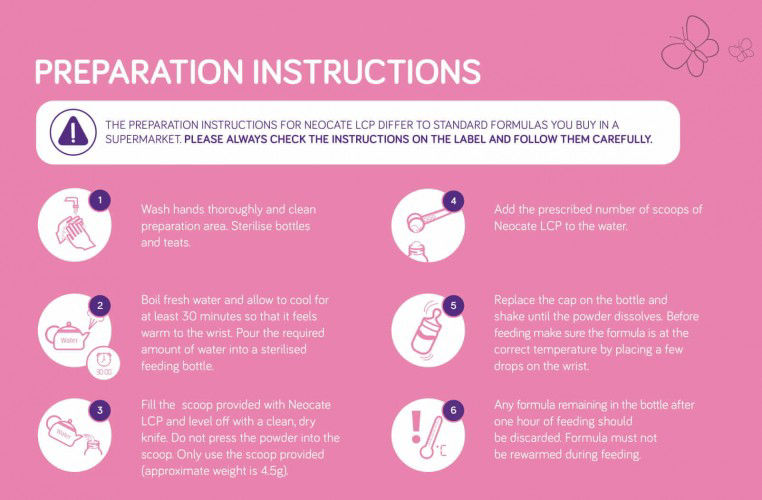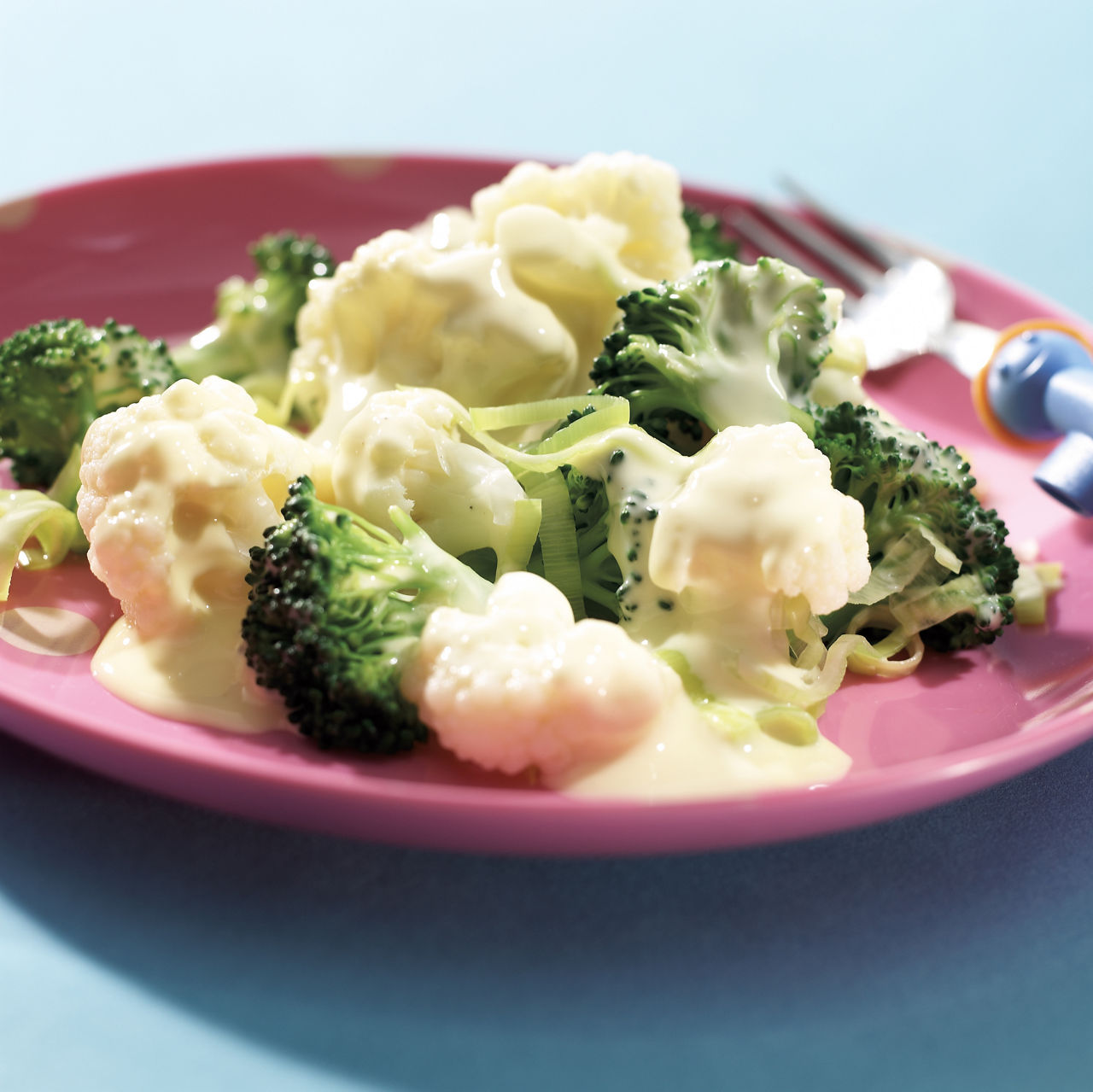Weaning a baby with Cow's Milk Allergy
Exciting times ahead
Weaning is when you start introducing semi-solid and solid foods into your little one's diet. This is a major advance in your child's development as you offer them new tastes and textures.
Weaning can be an enjoyable, yet challenging experience for parents. For children with cow's milk allergy or other allergic conditions, special care must be taken to make sure that certain foods are either avoided or only added under the guidance of your Healthcare Professional.
When to wean — introducing first foods to your baby’s diet
It is recommended that you begin to wean your baby when they are six months old;
3 signs that your baby may be ready to wean (Department of Health, Introducing solid foods, 2011.)
- Stay in a sitting position and hold their head steady
- Co-ordinate their eyes, hand and mouth so that they can look at the food, pick it up and put it in their mouth all by themselves
- Swallow food. Babies who are not ready will push their food back out, so they get more around their face than they do in their mouths!
Other signs that your baby may be ready to wean
- Showing interest in other people’s eating
- Chewing fists
- Waking during the night when previously had slept through
- Crying between feeds – baby still appears to be hungry after feeds
- Increasing milk feeds for a few days
Next steps
When your baby starts to show that they’re ready to start weaning, talk to your Healthcare Professional who will advise you. For children with cow’s milk allergy, your doctor or dietitian may recommend you wait until your baby is six months old before you start weaning. When the time does arrive, they may recommend Neocate Spoon for your baby.
Introducing new foods — a step by step guide
We know this bit isn’t always easy, but don’t be afraid to ask for help
- You can introduce complementary foods to your baby from six months onwards.
- Only introduce new foods when your child is well.
- Foods should be introduced one at a time so foods that trigger allergic reactions can be identified quickly.
- If your baby shows a reaction, stop the food you’re trying to introduce, record the symptoms and discuss them with your doctor or dietitian.
- The frequency with which each new food is introduced (daily/twice weekly/weekly) will vary. Your doctor or dietitian can advise you.
- If symptoms occur, wait approximately one to three days after symptoms have stopped before giving another new food. Carry on giving your child foods that are already tolerated.
Baby steps…
Step 1. Introduce thin and smooth foods
The first stage in your baby’s nutritional development should consist of thin and smooth foods. Help your child to explore new tastes and textures.
Your doctor or dietitian should recommend which food to start with, what amount to offer and the order in which to introduce new foods.
- Start with foods that are smooth in texture, lump-free and mild in taste. Peeled and home cooked potatoes, carrots, pears, or apples are favourites. Only offer one new food at a time.
- Home cooked foods are a good way to control all the ingredients used in the food you give your child.
- Foods can be cooked, mashed and placed in a container in the fridge for the same or the next day. They can also be filled in an ice cube container and frozen. Then, 1-2 cubes can be thawed as required.
- Mashed foods can be moistened with Neocate LCP or a little milk-free margarine.
- Avoid flavours, artificial colourings and additives (herbs, spices, stock cubes, salt and pepper) when buying commercially-prepared foods. Check with your child’s doctor or dietitian before giving commercially-prepared products and carefully read the ingredients listed on the label.
Neocate LCP is still suitable during this weaning period and can be used up until 12 months. Make sure your baby continues to take the recommended amount of formula to complement weaning. If in doubt, talk to your doctor or dietitian about the right amounts for your baby.
Step 2. Time for lumpy and chopped foods
As your baby starts eating more and more off a spoon, you can start introducing solid foods into his or her diet.
Once your baby has learned how to take soft food from a spoon, you can start to introduce mashed food with soft lumps to help develop your baby’s chewing skills.
As your baby gets older, you can mash, grate or dice foods. It is important to keep giving your baby different foods, tastes and textures. As allergic infants are often on a limited range of solid foods, always give your baby the recommended daily amount of your Neocate product to help ensure they get the nutrients they need.
At this stage, your child’s doctor might recommend Neocate LCP or Neocate Spoon. Neocate Spoon allows your baby to experience new tastes and textures in a hypoallergenic format. Being on a restricted diet can sometimes mean that some essential nutrients are left out. Neocate contains essential nutrients for growth and development. You’ll need to discuss the amount of formula needed by your baby with your doctor or dietitian. They’ll assess the nutritional content of your baby’s diet and adjust the amount of formula accordingly.
Step 3. Finger food fun
Your baby’s diet should become more varied over time. Make sure your child is happy and finds new foods he or she can eat by themself.
When starting on finger foods, your baby will also easily learn to drink from a cup and feed independently. Commercially prepared finger foods such as rusks, bread and biscuits may not be suitable for young children with food allergies. Only use these type of foods when you know your child can tolerate all the individual ingredients and always read food labels very carefully.
Finger foods to try with your baby
- Vegetables - cut into strips and steamed or microwaved to soften (e.g. cooked potato or carrot sticks)
- Fruit - ripe, peeled and cut into strips (e.g. pear, apple or melon)
- Rice shortbread
- Plain rice crackers or cake
- Meat - cooked and cut into strips (e.g. home cooked roast chicken or lamb)
- Homemade potato chips cooked in permissible oil (e.g. safflower, canola, sunflower)
Finding foods that can be tolerated may take time and patience. However, just because your child has cow’s milk allergy doesn’t mean they’ll have a reaction to all allergenic foods such as fish, eggs and wheat. These everyday foods are highly nutritious and should be introduced – unless you’re advised otherwise. Your child may love them and they could agree with your child.
During this period of trial and error, your doctor may recommend Neocate LCP or Neocate Spoon to supplement your infant’s diet. The amount of formula needed must be discussed with your doctor or dietitian who will assess the nutritional content of your baby’s diet and adjust the amount of formula accordingly.
Step 4. Following your child’s first birthday
From 12 months on, your toddler will move increasingly towards family meals. Offer your child as wide a range possible of grown up foods as their nutritional needs increase.
Eating as a family will encourage your baby to get into good habits from a young age. If your baby is used to eating the foods the rest of the family eats (although milk-free and cut up a bit smaller) then they are less likely to be a fussy eater as they get older. Here are some useful tips to help you have enjoyable family meals:
- Sit your baby in a highchair at the table and smile and talk to them to make them feel included.
- Give your baby the same home cooked food as the rest of the family, but remember to leave out the salt and foods containing cow’s milk.
- Encourage babies and young children to feed themselves with finger foods, and let them decide when they’ve had enough
- Don’t worry if feeding your baby is messy! It’s natural for babies to want to touch or play with their food when they’re beginning to feed themselves – it’s all part of learning. A plastic tablecloth, newspapers or an old sheet or towel on the floor will make it easier to clean up afterwards.
Cow’s milk allergy, like some other food allergies can be outgrown but it may take some time before it is safe to re-introduce a food that your baby initially reacted to. Discuss with your doctor or dietitian if and when it is safe to re-introduce cow’s milk in your child’s diet.
Winning weaning tips
Happy, healthy weaning
Some useful ideas to smooth the way as you wean your child onto first foods.
- If your child rejects a new food, don’t leave it off the menu. It can take as many as 20 exposures to a new food before a child will try it. Keep offering it on a regular basis and one day soon your child may snap it up.
- Try fading in a new food. Simply mix a small amount in with an accepted food. If your child rejects it, don’t return to the accepted food, simply reduce the ratio of the new food and keep moving forward.
- Children like routine. Provide meals and snacks with your child seated at a table or in a highchair at regular times during the day.
- For infants moving to solids, try to give them one or two opportunities a day to practice with a spoon.
- For a young child, three meals and three snacks a day is a typical schedule.
- For older children, this may be reduced to three meals and two snacks a day.
- No grazing. This can result in less food intake in a day, while eliminating hunger as a motivator to try something new.
- If your child is transitioning to a formula-only diet, it’s still useful to maintain a schedule and routine around mealtimes. This will give your child the developmental opportunities that arise with mealtimes such as language, social and fine motor skills, and lay the foundation for future diet expansion.
- Offer your child choices and they’ll be more motivated and involved with mealtimes. Let them choose between two cups for their lunchtime drink. Ask “Do you want sweet potato mash or roast sweet potatoes?”
- Avoid the “no” word. You can do this my saying “It’s time for a snack” rather than “Do you want a snack?”. And be careful about the expression on your face when you’re introducing new foods. A look that says “yuk” may influence your child to reject a food.
- Be playful. Don’t simply encourage eating or drinking. Encourage your child to explore the food with all their senses such as how it feels on the tongue and teeth. Show your child what great eyes slices of cucumber make.
- Be consistent. Whatever stage of transition you’re at, the more consistent you are, the quicker your child will learn.
- Keep your child interested in mealtimes by trying some of our latest tempting recipes.
When to ask for help
Weaning has its moments…
Here are a few thoughts on when it might be time to ask for advice from a specialist.
- Your child’s nutrition or growth are compromised
- Your child is unwilling to accept recommended diet/foods
- Your child is unwilling to drink recommended supplement or formula
- Your child isn’t participating in mealtimes
- Mealtimes are becoming stressful
- Feeding issues disrupt daily life
- Your child is unable or unwilling to eat certain textures of food
- Your child is not feeding as expected for their age or ability
What if Cow’s Milk Allergy persists after the first year? It’s natural to worry but you can still keep your child’s allergy under control. Discuss your options with your doctor or dietitian.


